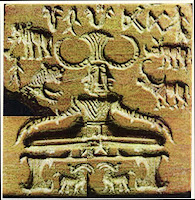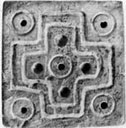http://tinyurl.com/gv74lm6
Contributions made by dhā̆vaḍ to Bronze Age Revolution
Contributions made by dhā̆vaḍ to Bronze Age Revolution
See:
http://bharatkalyan97.blogspot.in/2016/08/sangada-lathe-brazier-on-indus-script.html sangaḍa, 'lathe-brazier' on Indus Script corpora, rebus caṅkatam=saṃskṛta,dhā̆vaḍ 'iron smelters' of sangara'people of Hindoostan, Kutch'
Some intimations of the contributions of dhā̆vaḍ 'smelters' may be seen from examples of Indus Script Corpora. The entire Corpora is a datamine of metalwork catalogues.
![Image result for donal seated bharatkalyan97]()
![Image result for tiger jackal bharatkalyan97]()
![Image result for tiger jackal bharatkalyan97]()
Leaping tiger is an abiding hieroglyph-hypertext on Indus Script corpora as seen from these inscriptions.
Two etyma streams of Indian sprachbund can be related to this hypertext signifying 'tiger' and 'jumping'
Tiger, jackal
Hieroglyph: కోలు (p. 0329) [ kōlu ] kōlu. [Tel.] adj. Big, great, hugeపెద్ద. కోలుపులి or కోల్పులి a royal tiger. kul 'tiger' (Santali) kul 'tiger' (Santali); kōlu id. (Te.) kōlupuli = Bengal tiger (Te.)Pk. kolhuya -- , kulha -- m. ʻ jackal ʼ < *kōḍhu -- ; H.kolhā, °lā m. ʻ jackal ʼ, adj. ʻ crafty ʼ; G. kohlũ, °lũ n. ʻ jackal ʼ, M. kolhā, °lā m. krōṣṭŕ̊ ʻ crying ʼ BhP., m. ʻ jackal ʼ RV. = krṓṣṭu -- m. Pāṇ. [√kruś] Pa. koṭṭhu -- , °uka -- and kotthu -- , °uka -- m. ʻ jackal ʼ, Pk. koṭṭhu -- m.; Si. koṭa ʻ jackal ʼ, koṭiya ʻ leopard ʼ GS 42 (CDIAL 3615). कोल्हा [ kōlhā ] कोल्हें [ kōlhēṃ ] A jackal (Marathi)
Allograph: kōla = woman (Nahali)
Rebus: kolhe 'smelter' kol 'working in iron' kolle 'blacksmith' kol ‘furnace, forge’ (Kuwi) kol ‘alloy of five metals, pañcaloha’ (Ta.)
dhavvũ Rushing, Jumping, running
![Image result for gundestrup hair strand]()
Rebus1: dhāˊtu n. ʻ substance ʼ RV., m. ʻ element ʼ MBh., ʻ metal, mineral, ore (esp. of a red colour) ʼ Mn., ʻ ashes of the dead ʼ lex., ʻ *strand of rope ʼ (cf. tridhāˊtu -- ʻ threefold ʼ RV., ayugdhātu -- ʻ having an uneven number of strands ʼ KātyŚr.). [√dhā ]Pa. dhātu -- m. ʻ element, ashes of the dead, relic ʼ; KharI. dhatu ʻ relic ʼ; Pk. dhāu -- m. ʻ metal, red chalk ʼ; N. dhāu ʻ ore (esp. of copper) ʼ; Or.ḍhāu ʻ red chalk, red ochre ʼ (whence ḍhāuā ʻ reddish ʼ; M. dhāū, dhāv m.f. ʻ a partic. soft red stone ʼ (whence dhā̆vaḍ m. ʻ a caste of iron -- smelters ʼ, dhāvḍī ʻ composed of or relating to iron ʼ); -- Si. dā ʻ relic ʼ; -- S. dhāī f. ʻ wisp of fibres added from time to time to a rope that is being twisted ʼ, L. dhāī˜ f. (CDIAL 6773)
Rebus 2: uddhava1 m. ʻ sacrificial fire, festival ʼ lex. [√hu ] Pk. uddhavia -- ʻ worshipped ʼ; H. ūdhav, ūdho m. ʻ festival ʼ.(CDIAL 2012)
![]() Mohenjo-daro Seal m0352 shows dotted circles in the four corners of a fire-altar and at the centre of the altar together with four raised 'bun' ingot-type rounded features.
Mohenjo-daro Seal m0352 shows dotted circles in the four corners of a fire-altar and at the centre of the altar together with four raised 'bun' ingot-type rounded features.![Image result for dotted circle indus]() Ornaments worn on the forehead and right-shoulder are dotted circles. The shawl also has one, two and three dotted circles. Three dotted circles are organized orthographically like a trefoil.
Ornaments worn on the forehead and right-shoulder are dotted circles. The shawl also has one, two and three dotted circles. Three dotted circles are organized orthographically like a trefoil.
Evolution of Brahmi script syllables ḍha-, dha- are traced from Indus Script hieroglyph dāya 'dotted circle', dām 'rope (single strand or string?) to signify dhā̆vaḍ 'iron-smelter' (potR 'purifier priest').
S. Kalyanaraman
Sarasvati Research Center
August 28, 2016

Leaping tiger is an abiding hieroglyph-hypertext on Indus Script corpora as seen from these inscriptions.
Two etyma streams of Indian sprachbund can be related to this hypertext signifying 'tiger' and 'jumping'
Tiger, jackal
Hieroglyph: కోలు (p. 0329) [ kōlu ] kōlu. [Tel.] adj. Big, great, huge
Allograph: kōla = woman (Nahali)
Rebus: kolhe 'smelter' kol 'working in iron' kolle 'blacksmith' kol ‘furnace, forge’ (Kuwi) kol ‘alloy of five metals, pañcaloha’ (Ta.)
dhavvũ Rushing, Jumping, running
Hieroglyph: *dhavaka -- ʻ running ʼ. [√dhav ]Or. dhuã̄ ʻ running ʼ.6766 dhavatē ʻ runs ʼ RV. [√dhav ]K. dawun ʻ to run ʼ; G. dhavvũ ʻ to rush to ʼ. -- See Add.dhavala -- 1 ʻ Anogeissus latifolia ʼ see dhavá -- 1 .Addenda: dhavatē: S.kcch. dhoṛṇū ʻ to run ʼ; -- Md. duvanī, °venī ʻ runs ʼ, duvvanī ʻ drives ʼ (or < dhāˊvati 1 or drávati ).(CDIAL 6765a, 6766) *uddhāva ʻ running away ʼ. [√dhāv 1 ] B. udhāo subst. ʻ running out of one's sight ʼ (ODBL 663 < *uddhāvuka -- ).(CDIAL 2019) dravá ʻ running ʼ RV., ʻ flowing ʼ Kāṭh., m. ʻ quick motion ʼ Hariv., ʻ fluidity, juice, stream ʼ Kāv. [√dru ]Pa. dava -- m. ʻ running ʼ; Pk. dava -- m. ʻ water, anything wet ʼ; OG. davadavāe ʻ with speed ʼ; M. dãv n. ʻ dew, dampness, exudation from damp ground ʼ (despite gender rather than with LM 351 < Pk. daya<-> n. < udaká -- ); Si. dav ʻ play ʼ; -- Ash. dro ʻ woman's hair ʼ, Kt. drū, Wg.drū, drū̃; Pr. ḍui ʻ a hair ʼ; Kho. dro(h) ʻ hair ʼ, (Lor.) ʻ hair (of animal), body hair (human) ʼ: → Orm. dra , drī IIFL i 392 (semant. cf. Psht. pal ʻ fringe of hair over forehead ʼ < *pata -- ).drávati ʻ runs ʼ RV. [√dru ]Pk. davaï ʻ goes away ʼ; Paš.kuṛ. lēw -- ʻ to swim ʼ; Gaw. lōe ʻ swimming ʼ; -- Ḍ. dei -- ʻ to run ʼ prob. < dhāˊvati 1 . -- Ext. -- ḍ -- : K. dorun ʻ to run ʼ, rām. dauṛnu, kash. dōṛunu , ḍoḍ. dauṛṇō; S. ḍroṛaṇu ʻ to run, gallop ʼ; L. drôṛaṇ, dôṛaṇ ʻ to run ʼ, P. dauṛṇā, WPah.paṅ. dōuṛṇā; Ku.dauṛaṇo ʻ to run, hunt ʼ; A. dāuriba ʻ to run ʼ, B. dauṛā (← West ODBL 349), Or. daüṛibā, Aw.lakh. daurab, H. dauṛnā (→ Mth. dauṛab, N.dauṛnu); Marw. doṛṇo, G. doṛvũ, M. davaḍṇẽ, dauḍṇẽ; -- -- kk -- : S. ḍrokaṇu ʻ to gallop ʼ, ḍrukaṇu ʻ to run ʼ; L. drukkaṇ, (Ju.) drukaṇ, durkaṇ ʻ to run ʼ, dhrukkaṇ (X dhāvaṇ < dhāˊvati 1 ); -- N. dugurnu (*daur -- X *dukk -- ?). -- See drāváyati .draviḍa -- see *drāmiḍa -- .Addenda: drávati: Md. duvanī, duvenī ʻ runs ʼ, duvvanī ʻ drives ʼ (or < dhavatē or dhāˊvati 1 ); -- WPah.kṭg. (kc.) dɔṛnõ ʻ to run ʼ, kṭg. dəṛauṇõ, Wkc. dəṛe uṇo ʻ to drive away ʼ; Garh. dɔṛnu ʻ to run ʼ. -- Read B. dauṛā̆na.(CDIAL 6624) Addenda: dravá -- [Cf. Shgh. ċīw, ċōw, ċū ʻ single hair ʼ (CDIAL 6623)
|
Images of the egtyma signifying droh, ḍui 'hair' are seen on Gundestrup cauldron:Ash. dro ʻ woman's hair ʼ, Kt. drū, Wg.drū, drū̃; Pr. ḍui ʻ a hair ʼ; Kho. dro(h) ʻ hair ʼ, (Lor.) ʻ hair (of animal), body hair (human)ʼ Rebus: dhāu 'metal' dhā̆vaḍ 'smelter'
Rebus1: dhāˊtu n. ʻ substance ʼ RV., m. ʻ element ʼ MBh., ʻ metal, mineral, ore (esp. of a red colour) ʼ Mn., ʻ ashes of the dead ʼ lex., ʻ *strand of rope ʼ (cf. tridhāˊtu -- ʻ threefold ʼ RV., ayugdhātu -- ʻ having an uneven number of strands ʼ KātyŚr.). [√
Rebus 2: uddhava
 Mohenjo-daro Seal m0352 shows dotted circles in the four corners of a fire-altar and at the centre of the altar together with four raised 'bun' ingot-type rounded features.
Mohenjo-daro Seal m0352 shows dotted circles in the four corners of a fire-altar and at the centre of the altar together with four raised 'bun' ingot-type rounded features.Evolution of Brahmi script syllables ḍha-, dha- are traced from Indus Script hieroglyph dāya 'dotted circle', dām 'rope (single strand or string?) to signify dhā̆vaḍ 'iron-smelter' (potR 'purifier priest').
S. Kalyanaraman
Sarasvati Research Center
August 28, 2016